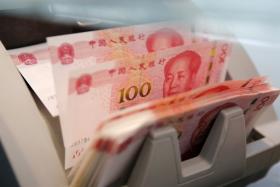WATCH: Here's your food, thanks to the flying robot
There was a drone flying towards Prime Minister Lee Hsien Loong.
He did not move away, and people were smiling and taking photos.
The reason?
It was flying the Singapore flag towards him.
The drone is a Flying Robotic Intelligent Server (Fris) created by Infinium Robotics to increase the productivity of waiters in restaurants.
Infinium Robotics is a Singapore company located both here and in Silicon Valley, California, in the US.
The company's key business activity is in supplying robotic productivity solutions to enhance value in the food and beverage (F&B), construction and logistics sectors.
The Fris demonstration took place at a showcase yesterday at the Suntec Singapore Convention & Exhibition Centre for National Productivity Month 2014.
One drone served two bowls of noodles to a pair of customers, before another drone carrying the Singapore flag flew towards PM Lee.
CEO of Infinium Robotics, Mr Woon Junyang, 31, took the flag and passed it to him.
Mr Woon told The New Paper yesterday, that the idea for the smart flying robots came about during his dining experiences in restaurants here.
Mr Woon, 31, said: "In many restaurants, sometimes your food is served cold, and sometimes there aren't any waiters around.
"So that's why I thought a flying robot would work in serving food in restaurant autonomously."
One difficulty Mr Woon faced was in trying to convince people that the drones are safe and can change the way restaurant operations work.
He said: "It's understandable that people have questions about new technology.
"So we want to show that the drones are safe and that they won't hit any customers."
PRICE TAG
Work on the drones started in January this year. While there is no price tag for them at the moment, Mr Woon said it will be made as low as possible for businesses.
The drones are powered by different kinds of batteries but there are autonomous charging stations.
For example, if a drone is done serving its order, it will return to the charging pad.
The drones are controlled using an infrared tracking system and radio positioning triangulation, and the computer that is controlling them runs autonomously.
The current prototype can carry objects as heavy as 300g to 500g, but it can carry heavier products simply by scaling it up and building a stronger motor.
Mr Woon said it felt like magic when the drones first worked a few months ago in the laboratory: "There were moments of elation, even though there was still more work to be done.
"We were creating something that flies in the air.
"We're engineers, yet at the same time like magicians."

A combination of technology such as infrared, radio frequency and triangulation can track the drones up to 1cm
Customers order food using tablets
Drones carrying food from the kitchen fly to the customers
The drones will hover in a stationary position while customers collect their food
Prototype drones can carry up to 500g of food. Future models are expected to carry heavier loads
For safety, wire mesh is used to prevent people from touching the propeller blades
The drone uses several sensors to prevent collision and to maintain its own balance
"Productivity is a long haul, but so long as we have confidence and keep working at it together, it can be done."
- Prime Minister Lee Hsien Loong
Wage rise depends on productivity
If you want wages to rise, then productivity is key.
Prime Minister Lee Hsien Loong said this in his speech to over 800 businessmen at the inaugural National Productivity Month, held by the Singapore Business Federation and Singapore National Employers Federation yesterday at the Suntec Singapore Convention & Exhibition Centre.
He said that in the short term, wages may rise by themselves in a tight labour market, but in the longer run, wage rises can be sustained only through higher productivity.
He outlined the Government's three-pronged approach to achieve this.
First, there are incentives and schemes to support firms to upgrade productivity, whether by investing in technology, training workers or streamlining operations.
There are also schemes tailored to companies in individual sectors, which they can tap on to make productivity and innovation improvements and to upgrade their workers.
There has been a steady increase in the take-up of such schemes, Mr Lee said.
Second, foreign worker inflow is being controlled in order to put pressure on employers to upgrade their workers, instead of just hiring more.
ENOUGH ACCESS
But companies still get enough access to foreign workers to complement their Singaporean workforce, so businesses can survive and Singaporean jobs do not disappear.
He said: "As I said last week, I do not expect any further major measures to tighten our foreign worker numbers."
The third prong is making the productivity drive a national effort.
Mr Lee set out the different roles which players should take.
Companies must have a "productivity mindset" and not be afraid to change for the sake of efficiency.
Employers must seek to improve their operations, recognise their workers' skills, and value and train workers.
But businesses are not the only ones that have to change their mindset - customers must accept changes in the business models such as self-service formats, he added.
Get The New Paper on your phone with the free TNP app. Download from the Apple App Store or Google Play Store now


